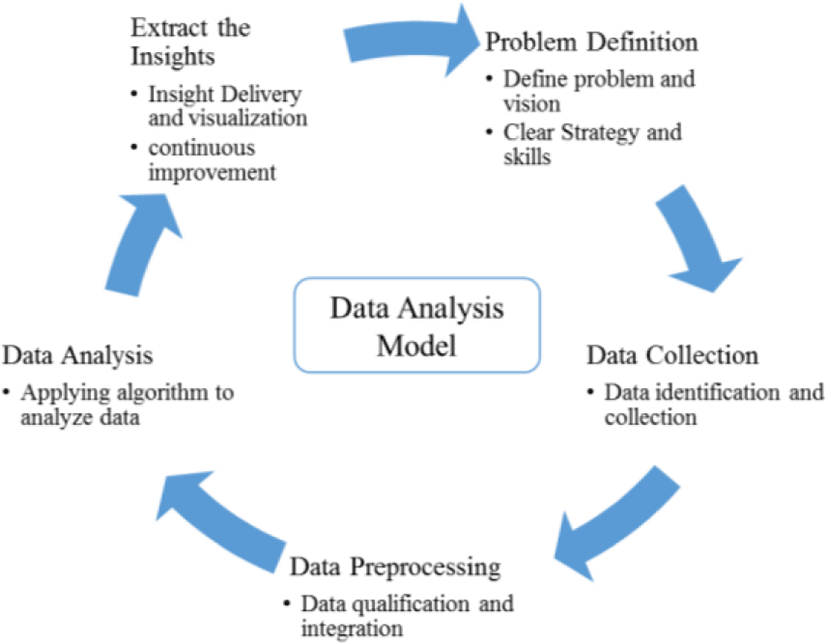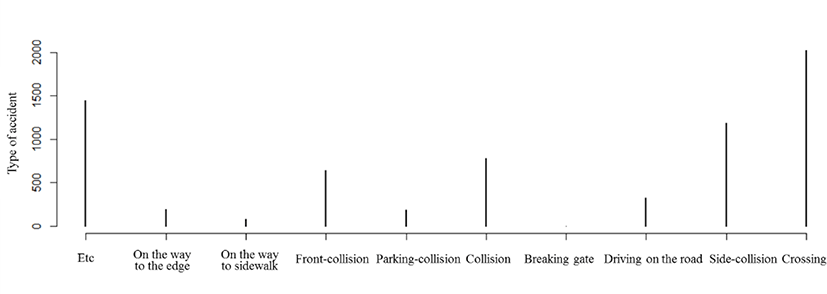I. INTRODUCTION
Korea has frequent traffic accidents because of its geographical and sociological characteristics compared to other countries. Traffic accident analysis is necessary to understand the factors affecting traffic accidents, and to reduce or control traffic accidents. Traffic accidents are caused by a combination of factors such as human factors, social factors, and environmental factors. Drinking, drowsiness driving, and driving carelessness are the main causes of traffic accidents, but there is not much research to analyze the association of various factors. Therefore, it is very interesting to understand the reasons and factors of traffic accidents in Korea.
In this paper, we find out the association rules based on various factors to analyze the causes of traffic accidents. We first collect the traffic accident data generated in Korea and preform the preprocessing phase for analysis. And then, we analyze the data to derive its meaning and discuss the results. Here, the analysis performs a basic statistical analysis considering various properties and we use the Apriori algorithm for the association analysis.
The rest of this paper is organized as follows. Section 2 describes the previous work related to this paper. Section 3 explains a model for traffic accident factor analysis, and Section 4 analyzes the cause of traffic accident accordingly. Section 5 summarizes and concludes the paper.
II. RELATED WORD
In this section, we discuss the related work. First, there have been various studies to analyze the cause and severity of traffic accidents. Li et al. [5] applied data mining algorithms such as Apriori algorithm, Naïve Bayses classifier and k-means clustering algorithm on the roadway traffic data. The authors performed the analysis, including weather, light conditions or surface condition. However, an analysis between more closely related attributes to the accident, such as the accident type or the road type is needed. Chong et al. [3] applied machine learning algorithms to model the severity of injury that occurred during traffic accidents. They considered neural networks trained using hybrid learning approaches, support vector machines, decision trees, and concurrent hybrid model involving decision trees and neural networks. Also, decision tree used for analyzing and founding the traffic accident patterns of N5 National Highway in Bangladesh in [8] Oña et al. [6] presented an analysis accidents on rural highway in Spain using Bayesian Networks to classify traffic accidents according to their injury severity. In [10], a model was proposed to predict the severity of traffic accidents in Abu Dhabi. Abellán et al. [1] proposed an effective method for extracting rules from decision tree to extract some important relationships between variables. And they applied the proposed method to obtain relevant rules from rural road traffic accident data in Spain. In [7], authors analyzed the traffic accident injury severity on Slovenian roads with a classification and regression tree algorithm. Castro and Kim [2] use Bayesian network, decision tree and artificial neural networks to detect factors with the greatest influence on car accidents in United Kingdom.
Also, there are several studies that analyze about traffic accidents in Korea. A structural equation model (SEM) [4] is proposed to correlate the variables related to traffic accidents. It uses accident data occurred on highways in Korea and estimate relationship among exogenous factors and traffic accident size. Sohn et al. [9] applied data mining techniques to estimate and classify severity types of road traffic accidents in Korea. They used neural network, logistic regression and decision tree to select a set of influential factors and to build up classification modes for accident severity.
III. BIG DATA MODEL DESIGN FOR TRAFFIC ACCIDENT FACTOR ANALYSIS
In this section, we design a big data model for traffic accident analysis and explain step by step. Figure 1 shows a model designed to analyze traffic accident factors. The first step is to define the problem and clear strategy for analyzing. In this paper, we define the problem as analyzing the causes and association rules of traffic accidents in Korea. The second step is to collect data for the big data analysis. We use traffic deaths data occurred in 2015-2016 in Korea for this study. Next, in the third step, we determine the properties of collected data and perform preprocessing. In the fourth step, we analyze the data with statistical method and Apriori algorithm. In the final step, we derive the insights based on the analyzed results.
IV. TRAFFIC ACCIDENT FACTOR ANALYSIS
In this section, we analyze traffic accident factors through various perspectives according to the model designed in Section 3.
In this section, we describe the data cleaning phase. First, we describe the data used in the analysis, and explain the preprocessing step of the collected data.
The aim of this study is to analyze the factors of traffic accidents in Korea. We use the traffic accident data provided by the government for the analysis, which are occurred in 2015 and 2016. The collected data includes 23 attributes, such as the date and time of the accident, type of accident, the number of deaths and injured people, etc., and the data is provided in csv format. Table 1 summarizes the main attributes of the collected data.
In this section, we describe the process of preprocessing the collected data for analysis. Since the data currently available only provide information relevant to the occurrence of a traffic accident, we could not determine the scale of the accident. Therefore, in this paper, we create a variable called ‘severity’ which can measure the scale of an accident, so that the scale of the accident can be quantified and the degree of accident ca be easily identified. The variable ‘severity’ is used to measure the scale of accident. For this, we weighted the variables ‘Number of deaths’, ‘Number of seriously injured people’, ‘Number of slightly injured people’ and ‘Number of injured people’, which indicate the number of traffic accident victims. And the severity of the accident is shown in Equation (1).
In addition, we create a variable ‘Scale of accident’ by categorizing the ‘severity’ to better understand. If the severity is higher than 50, it derives the attribute ‘Large-scale accident’; if it is higher than 20, it derives ‘Medium-scale accident’; if it is lower than 20, it derives ‘Small-scale accident’.
In this section, we analyze the data and describe the result. First, we performed statistical analysis based on the attributes of the preprocessed data. Figure 2 shows the result of analysis of traffic accident with type of accident, and the most accident occurred during the crossing.
Table 2 shows the result of traffic accident analysis according to the ‘Scale of accident’, which is derived from section 4.1.2. In Table 2, small-scale accident is occurred more than large-scale accident. Large-scale accidents are the least number of accident, however, they should be more cautious because the number of deaths and injured people. Also, it is considered the main reason of traffic accident varies depending on the scale of accident. Thus, in this paper, we analyze the traffic accident according to the scale of accident.
| Small-scale Accident | Medium-scale Accident | Large-scale Accident | |
|---|---|---|---|
| Number of cases | 6,738 | 103 | 15 |
Next, we analyze the traffic accident by scale of accidents. In this paper, we used Apriori algorithm, which is an algorithm to find out association rules to analysis.
In this section, we analyze the large-scale accident which has severity higher than 50. The scale of this accident is large and it does not occurs often. For the experiment, we set the minimum support as 0.4 and the reliability as 0.8. The more frequent associate rules indicate that the time of accident is during the day time and the type of victim vehicle is the vans. It means that many large-scale accident occurs during the day time because the amount of vehicle traffic in day time is more than night time, and also there are many passengers on the vans. And many large-scale accidents occurs when the type of accident is ‘ongoing-collision’. Also, if people do not follow the ‘Safety driving obligation’, there are many large-scale accident occurs.
In this section, we analyze the medium-scale accident which has severity higher than 20 and lower than 50. First, medium-scale accident has more occurred during day time than night time. However, it is more occurred during day time than night time only 1.16 times, so there is no big difference. This means that medium-scale accident occurs frequently regardless of time of day. In addition, both vehicle of the accident and victim are ‘passenger cars’, and it means the number of passengers are less than that of ‘van’, but the number of accident is higher.
In this section, we analyze the small-scale accident which has severity lower than 20. Small-scale accident are most frequent because the number of death and injured people is lower than other accidents. Unusual point in small-scale accident is that it more occurs during night time than day time. Though it is a slight difference, it means small-scale accident frequently occurs during night time whereas other accidents are more occur in day time. Also, there are the victim is most likely a ‘pedestrian’ rather than a vehicle. This means that in the case of a small-scale accident, there are many accidents occur between vehicle and pedestrians rather than between vehicles. Table 3 shows some of the results to find out an association rules from large-scale accident data. The rule that has higher support and confidence is the more associated rule.
V. CONCLUSION
In this paper, we analyze the factors and association rules of traffic accident from 2015 to 2016 in Korea. The analysis shows that most of the accidents are caused by the driver’s failure to safely drive. If improving the driver’s careless driving attitude, it would be greatly reduce traffic accident. In addition, the result of analysis by the type of accident shows that many large-scale accident occurs by vans. Since the number of passengers are more than other vehicles, more attention of drivers and passengers of van is needed. In the case of medium-scale accident, many accidents occurred between cars, and in the case of small-scale accident, many accidents occurred between car and pedestrians. As for the future work, we would try to predict the severity of traffic accidents by using the detected association rules.









